Behavior of Demountable Connections with Taper Threaded Mechanical Coupler (TTC) and Rebar Anchor Under Tension Load
Abstract
1. Introduction
2. Experimental Tests
2.1. Connector Configuration and Experimental Approach
2.2. Pull-Out Tests
2.2.1. Experimental Program and Test Set-Up
2.2.2. Loading and Measurement Procedures
2.3. In-Air Tests
2.3.1. Experimental Program and Test Set-Up
2.3.2. Loading and Measurement Procedures
2.4. Material Properties
3. Experimental Test Results
3.1. Pull-Out Tests
3.1.1. Failure Modes
3.1.2. Load-Uplift Behavior
3.2. In-Air Tests
3.2.1. Failure Modes
3.2.2. Load-Deformation Behavior
4. Discussion
4.1. Comparative Analysis of Test Results
4.1.1. Resistance of the Connection Under Tension Load
4.1.2. Deformability of the Connection Under Tension Load
4.2. Design Recommendations
5. Conclusions
- Failure mode of the connection with high strength bolts (nominal grade 8.8) was governed by the stripping failure of taper threaded end of rebar anchor, at the connection with mechanical coupler. However, the ultimate tension resistance of the connection was practically the same as the ultimate tension resistance of the corresponding control reinforcing bar (less than 4% difference). Furthermore, strains in rebar anchor at ultimate load were higher than required for reinforcement splices with mechanical couplers;
- Failure mode of the connection with bolt grade 5.8 was governed by failure of the demountable bolt;
- Concrete strength did not affect the tension resistance of the connection with bolt grade 8.8. However, higher deformability of the connection for lower concrete strength was obtained, with minor cracking of the RC element. Specimens with smaller connector diameters had lower strength and higher deformability, albeit no visible cracks were detected. The highest deformability at failure had a specimen with bolt grade 5.8;
- Average ultimate tension resistance of connection obtained from pull-out tests on single connectors embedded in concrete with M20 bolts grade 8.8 was equal to 134.7 kN (CoV = 2.6%), while average tension resistance of the connection with M16 bolts was 77.0 kN (CoV = 4.9%). Ultimate tension resistance of the connection with M20 bolt grade 5.8 was 127.0 kN, obtained from one test specimen;
- Implementation of component method for simple analysis of global behavior of the connection and local behavior of the connector showed good match with test results. Prediction equations for resistance and deformation capacity under tension load were defined for each component of the connection, at yield and ultimate phases;
- The design equations are defined under the assumption that concrete failure is precluded by designing the anchorage length and shape of the rebar anchor according to EN 1992-1-1:2004 [26]. Therefore, tension resistance of the connection can be based on the tension resistance of the “weakest” component of the connector (bolt, mechanical coupler, or rebar anchor);
- The deformation capacity of steel components was defined based on bilinear stress-strain curves. A simplified empirical prediction equation for calculating the deformation of the connector due to concrete damage inside the anchor bent was proposed. This equation is based on connector resistance, concrete strength, and mandrel diameter of the rebar anchor. Due to the limited number of specimens, further research is needed to validate the proposed equations;
- In order to achieve full utilization of demountable bolt resistance, it is recommended to use the connectors with the lowest bolt-to-rebar anchor strength ratio. In these cases, apart from steel elements, the RC elements and the embedded part of the connectors also have great potential for reuse;
- For practical implementation of demountable connectors with mechanical couplers and rebar anchors in steel-concrete connections, further investigation of the connection’s behavior under combined shear and tension loads is needed. Furthermore, the behavior of connectors in groups should be investigated in further investigations.
Author Contributions
Funding
Data Availability Statement
Conflicts of Interest
Notations
| As,a | Nominal cross-section area of rebar anchor |
| As,b | Tensile stress area of demountable bolt |
| As,co | Tensile stress area of the hollow hexagonal section of the mechanical coupler |
| c | Concrete edge distance from connector axis |
| da | Nominal diameter of rebar anchor |
| db | Nominal diameter of demountable bolt |
| dco | Nominal (smaller) outer diameter of the hollow hexagon section of the mechanical coupler |
| dT,y | Uplift between steel and RC element at yielding load |
| dT,u | Uplift between steel and RC element at ultimate load |
| dt,y | Elongation of the connector at yielding load |
| dt,u | Elongation of the connector at ultimate load |
| Dm | Mandrel diameter of rebar anchor |
| Δa | Deformation of rebar anchor under tension load |
| Δb | Deformation of demountable bolt under tension load |
| Δc | Deformation of concrete under tension load |
| Δco | Deformation of mechanical coupler under tension load |
| εu,a | Strain at ultimate strength of rebar anchor fu,a |
| εu,b | Strain at ultimate strength of demountable bolt fu,b |
| εu,co | Strain at ultimate strength of mechanical coupler fu,co |
| εu,a,con | Strain of rebar anchor at ultimate resistance of connector under taper thread failure |
| Ecm(t) | Modulus of elasticity of concrete at the age of testing |
| Es,a | Modulus of elasticity of rebar anchor |
| Es,b | Modulus of elasticity of demountable bolt |
| Es,co | Modulus of elasticity of mechanical coupler |
| fcm(t) | Concrete cylinder compressive strength at the age of testing |
| fcm,cube(t) | Concrete cube compressive strength at the age of testing |
| fctm(t) | Concrete tensile strength at the age of testing |
| fctm,sp(t) | Concrete splitting tensile strength at the age of testing |
| fu,a | Ultimate stress of rebar anchor |
| fu,b | Ultimate stress of demountable bolt |
| fu,co | Ultimate stress of mechanical coupler |
| fy,a | Yield stress of rebar anchor |
| fy,b | Yield stress of demountable bolt |
| fy,co | Yield stress of mechanical coupler |
| Ka | Stiffness of rebar anchor |
| Kb | Stiffness of demountable bolt |
| Kco | Stiffness of mechanical coupler |
| py,c | Concrete compressive stress inside anchor bent under yield strength of the connector |
| pu,c | Concrete compressive stress inside anchor bent under ultimate strength of the connector |
| Tu,a | Ultimate resistance of rebar anchor under tension load |
| Tu,b | Ultimate resistance of demountable bolt under tension load |
| Tu,co | Ultimate resistance of mechanical coupler under tension load |
| Tu,con | Ultimate resistance of the connector under tension load |
| Ty,a | Resistance of rebar anchor at yield |
| Ty,b | Resistance of demountable bolt at yield |
| Ty,co | Resistance of mechanical coupler at yield |
| Ty,con | Resistance of the connector at yield |
Appendix A
| Specimen Series | Connector Component | Characteristics of Connector Components | Component Resistance | Connector Resistance | ||||||||
|---|---|---|---|---|---|---|---|---|---|---|---|---|
| di (mm) | As,i a (mm2) | fy,i (MPa) | Es,i (GPa) | fu,i (MPa) | εu,i (%) | Lt,i (mm) | Ty,i (kN) | Tu,i (%) | Ty,con (kN) | Tu,con (kN) | ||
| A-T, B-T (Bolt 8.8) | Bolt | 20.0 | 245.0 | 862.7 | 203.7 | 940.3 | 6.55 | 46.8 | 211.4 | 230.4 | ||
| Coupler | 27.0 | 317.2 | 778.5 | 209.3 | 843.5 | 2.12 | 25.5 | 246.9 | 267.6 | |||
| Reb. Anchor | 16.0 | 201.0 | 549.9 | 197.3 | 663.0 | 7.67 b | 60.3 | 110.5 | 133.3 | 110.5 | 133.3 | |
| C-T (Bolt 8.8) | Bolt | 16.0 | 157.0 | 847.7 | 197.4 | 916.6 | 5.61 | 44.0 | 133.1 | 143.9 | ||
| Coupler | 22.0 | 218.1 | 653.4 | 203.1 | 715.7 | 2.11 | 25.0 | 142.5 | 156.1 | |||
| Reb. Anchor | 12.0 | 113.0 | 582.4 | 202.9 | 667.8 | 6.74 b | 118.3 | 65.8 | 75.5 | 65.8 | 75.5 | |
| D-T (Bolt 5.8) | Bolt | 20.0 | 245.0 | 440.6 | 207.9 | 501.7 | 2.68 | 46.8 | 107.9 | 122.9 | 107.9 | 122.9 |
| Coupler | 27.0 | 317.2 | 778.5 | 209.3 | 843.5 | 2.12 | 25.5 | 246.9 | 267.6 | |||
| Reb. Anchor | 16.0 | 201.0 | 549.9 | 197.3 | 663.0 | 7.67 b | 60.3 | 110.5 | 133.3 | |||
| Specimen Series | Connection Component | Concrete Component | Component Deformation | Calculated Uplift | Measured Mean Uplift | Test-to-Predict Ratio | |||||
|---|---|---|---|---|---|---|---|---|---|---|---|
| fcm(t) (MPa) | Dm (mm) | Δy,i (mm) | Δu,i (mm) | dT,y,calc (mm) | dT,u,calc (mm) | dT,y,exp (mm) | dT,u,exp (mm) | dT,y,exp/dT,y,calc (−) | dT,u,exp/dT,u,calc (−) | ||
| A-T | Bolt | 24.9 | 250.0 | 0.065 | 0.078 | 1.10 | 5.75 | 1.21 | 6.33 | 1.100 | 1.101 |
| Coupler | 0.040 | 0.048 | |||||||||
| Reb. Anchor | 0.168 | 4.626 | |||||||||
| Concrete | 0.827 | 0.997 | |||||||||
| B-T | Bolt | 39.4 | 250.0 | 0.065 | 0.078 | 0.88 | 5.49 | 0.79 | 5.19 | 0.897 | 0.946 |
| Coupler | 0.040 | 0.048 | |||||||||
| Reb. Anchor | 0.168 | 4.626 | |||||||||
| Concrete | 0.608 | 0.733 | |||||||||
| C-T | Bolt | 24.9 | 150.0 | 0.058 | 0.067 | 0.99 | 8.72 | 0.86 | 5.75 | 0.869 | 0.659 |
| Coupler | 0.033 | 0.037 | |||||||||
| Reb. Anchor | 0.340 | 7.978 | |||||||||
| Concrete | 0.559 | 0.641 | |||||||||
| D-T | Bolt | 24.9 | 250.0 | 0.062 | 1.337 | 1.07 | 4.90 | 1.28 | 5.10 | 1.193 | 1.041 |
| Coupler | 0.039 | 0.044 | |||||||||
| Reb. Anchor | 0.164 | 2.597 | |||||||||
| Concrete | 0.808 | 0.920 | |||||||||
References
- World Steel Assosiation, Steel—The Permanent Material in the Circular Economy. 2023. Available online: https://worldsteel.org/circular-economy (accessed on 9 January 2025).
- Wong, R.W.M.; Loo, B.P.Y. Sustainability implications of using precast concrete in construction: An in-depth project-level analysis spanning two decades. J. Clean. Prod. 2022, 378, 134486. [Google Scholar] [CrossRef]
- Brambilla, G.; Lavagna, M.; Vasdravellis, G.; Castiglioni, C.A. Environmental benefits arising from demountable steel-concrete composite floor systems in buildings. Resour. Conserv. Recycl. 2018, 141, 133–142. [Google Scholar] [CrossRef]
- Kozma, A.; Odenbreit, C.; Braun, M.V.; Veljkovic, M.; Nijgh, M.P. Push-out tests on demountable shear connectors of steel-concrete composite structures. Structures 2019, 21, 45–54. [Google Scholar] [CrossRef]
- EN 1994-1-1; Eurocode 4: Design of Composite Steel and Concrete Structures. Part 1-1: General Rules and Rules for Buildings. Committee European for Standardization (CEN): Brussels, Belgium, 2004.
- Henriques, J.; da Silva, L.S.; Valente, I. Design model for composite beam-to-reinforced concrete wall joints. Steel Constr. 2013, 6, 19–26. [Google Scholar] [CrossRef]
- Ruopp, J.; Kuhlmann, U. Steel-to-concrete joints with large anchor plates under shear loading. Steel Constr. 2017, 10, 115–124. [Google Scholar] [CrossRef]
- Da Silva, L.S. Towards a consistent design approach for steel joints under generalized loading. J. Constr. Steel Res. 2008, 64, 1059–1075. [Google Scholar] [CrossRef]
- Radnay, L.; Kovács, I. Modified Use of the Component Method to Get More Realistic Force Distribution in Joints of Steel Structures. Buildings 2024, 14, 3553. [Google Scholar] [CrossRef]
- Hawkins, N.M. Strength in Shear and Tension of Cast-in-Place Anchor Bolts. Spec. Publ. 1987, 103, 233–256. [Google Scholar] [CrossRef]
- Dai, X.H.; Lam, D.; Saveri, E. Effect of Concrete Strength and Stud Collar Size to Shear Capacity of Demountable Shear Connectors. J. Struct. Eng. 2015, 141, 04015025. [Google Scholar] [CrossRef]
- Kwon, G.; Engelhardt, M.D.; Klingner, R.E. Behavior of post-installed shear connectors under static and fatigue loading. J. Constr. Steel Res. 2010, 66, 532–541. [Google Scholar] [CrossRef]
- Pavlović, M.; Marković, Z.; Veljković, M.; Buđevac, D. Bolted shear connectors vs. headed studs behaviour in push-out tests. J. Constr. Steel Res. 2013, 88, 134–149. [Google Scholar] [CrossRef]
- Deng, P.; Niu, Z.W.; Shi, Y.H.; Liu, Y.; Wang, W.L. Shear Performance of Demountable High-Strength Bolted Connectors: An Experimental and Numerical Study Based on Reverse Push-Out Tests. Buildings 2024, 14, 1052. [Google Scholar] [CrossRef]
- Tan, E.L.; Varsani, H.; Liao, F. Experimental study on demountable steel-concrete connectors subjected to combined shear and tension. Eng. Struct. 2019, 183, 110–123. [Google Scholar] [CrossRef]
- Wang, G.; Xian, B.; Ma, F.; Fang, S. Shear Performance of Prefabricated Steel Ultra-High-Performance Concrete (UHPC) Composite Beams under Combined Tensile and Shear Loads: Single Embedded Nut Bolts vs. Studs. Buildings 2024, 14, 2425. [Google Scholar] [CrossRef]
- Mahrenholtz, P.; Wood, R.L. Design of post-installed and cast-in-place anchors according to the new EN 1992-4 and ACI 318-19. Struct. Concrete 2021, 22, 650–665. [Google Scholar] [CrossRef]
- EN 1992-4; Eurocode 2: Design of Concrete Structures. Part 4: Design of Fastenings for Use in Concrete. Committee European for Standardization (CEN): Brussels, Belgium, 2018.
- Vita, N.; Sharma, A.; Hofmann, J. Bonded anchors with post-installed supplementary reinforcement under tension loading—Experimental investigations. Eng. Struct. 2022, 252, 113754. [Google Scholar] [CrossRef]
- Yang, F.; Liu, Y.; Jiang, Z.; Xin, H. Shear performance of a novel demountable steel-concrete bolted connector under static push-out tests. Eng. Struct. 2018, 160, 133–146. [Google Scholar] [CrossRef]
- Nijgh, M.P.; Gîrbacea, I.A.; Veljkovic, M. Elastic behaviour of a tapered steel-concrete composite beam optimized for reuse. Eng. Struct. 2019, 183, 366–374. [Google Scholar] [CrossRef]
- Yrjölä, J.; Bujnak, J. Shear tests on demountable precast column connections. Struct. Concr. 2021, 22, 2432–2442. [Google Scholar] [CrossRef]
- Zhou, Q.; Liu, Y.; Li, Y. Load transfer mechanism of precast concrete piers with demountable connections. Eng. Struct. 2022, 261, 114287. [Google Scholar] [CrossRef]
- Milosavljević, B.; Milićević, I.; Pavlović, M.; Spremić, M. Static behaviour of bolted shear connectors with mechanical coupler embedded in concrete. Steel Compos. Struct. 2018, 29, 257–272. [Google Scholar] [CrossRef]
- Milićević, I.; Milosavljević, B.; Pavlović, M.; Spremić, M. Bolted connectors with mechanical coupler embedded in concrete: Shear resistance under static load. Steel Compos. Struct. 2020, 36, 321–337. [Google Scholar] [CrossRef]
- EN 1992-1-1; Eurocode 2—Design of Concrete Structures—Part 1-1: General Rules and Rules for Buildings. European Committee for Standardization (CEN): Brussels, Belgium, 2004.
- Delhomme, F.; Roure, T.; Arrieta, B.; Limam, A. Pullout behavior of cast-in-place headed and bonded anchors with different embedment depths. Mater. Struct. 2015, 49, 1843–1859. [Google Scholar] [CrossRef]
- Lin, Z.; Liu, Y.; He, J. Behavior of stud connectors under combined shear and tension loads. Eng. Struct. 2014, 81, 362–376. [Google Scholar] [CrossRef]
- Milićević, I.; Milosavljević, B.; Spremić, M.; Mandić, R.; Popović, M. Local behaviour of the connector with mechanical coupler and rebar anchor under tension load. Build. Mater. Struct. 2023, 66, 107–114. [Google Scholar] [CrossRef]
- EN 1990, EN 1990:2002; Eurocode—Basis of Structural Design. Committee European for Standardization (CEN): Brussels, Belgium, 2002.
- EN ISO 6892-1; Metallic Materials—Tensile Testing—Part 1: Method of Test at Room Temperature II. European Committee for Standardization (CEN): Brussels, Belgium, 2016.
- EN ISO 15630-1; Steel for the Reinforcement and Prestressing of Concrete—Test Methods—Part 1: Reinforcing Bars, Rods and Wire. European Committee for Standardization (CEN): Brussels, Belgium, 2019.
- Chiari, V.G.; Moreno Junior, A.L. Experimental evaluation of coupler behavior for mechanical rebar splices in reinforced concrete structures. Rev. IBRACON Estrut. Mater. 2018, 11, 1326–1339. [Google Scholar] [CrossRef]
- ISO 15835-1; Steels for the Reinforcement of Concrete—Reinforcement Couplers for Mechanical Splices of Bars—Part 1: Requirements. ISO: Geneva, Switzerland, 2018.
- FIB Bulletin No. 10. Bond of Reinforcement in Concrete; FIB Bulletin, FIB: Lausanne, Switzerland, 2000; Volume 10. [Google Scholar]
- Minor, J. A Study of Bent Bar Anchorages in Concrete. Ph.D. Thesis, Rice University, Houston, TX, USA, 1971. [Google Scholar]
- EAD 330012-00-0601; Cast-in Anchor with Internal Threaded Socket. European Organisation for Technical Assessment (EOTA): Brussels, Belgium, 2015.
- EN 1993-1-8; Eurocode 3: Design of Steel Structures—Part 1-8: Design of Joints. European Committee for Standardization (CEN): Brussels, Belgium, 2005.
- European Convention for Constructional Steelwork—ECCS. Design of Composite Joints for Buildings. In Technical Committee 11, Composite Structures; ECCS Publication No. 109, 1st ed.; ECCS: Brussels, Belgium, 1999. [Google Scholar]
- Sperry, J.; Darwin, D.; O’Reilly, M.; Lepage, A.; Lequesne, R.D.; Matamoros, A.; Feldman, L.R.; Yasso, S.; Searle, N.; DeRubeis, M.; et al. Conventional and high-strength steel hooked bars: Detailing effects. ACI Struct. J. 2018, 115, 247–257. [Google Scholar] [CrossRef]
- Eligehausen, R.; Mallée, R.; Silva, J.F. Anchorage in Concrete Construction, 1st ed.; Ernst & Sohn: Berlin, Germany, 2006; pp. 128–137. [Google Scholar]


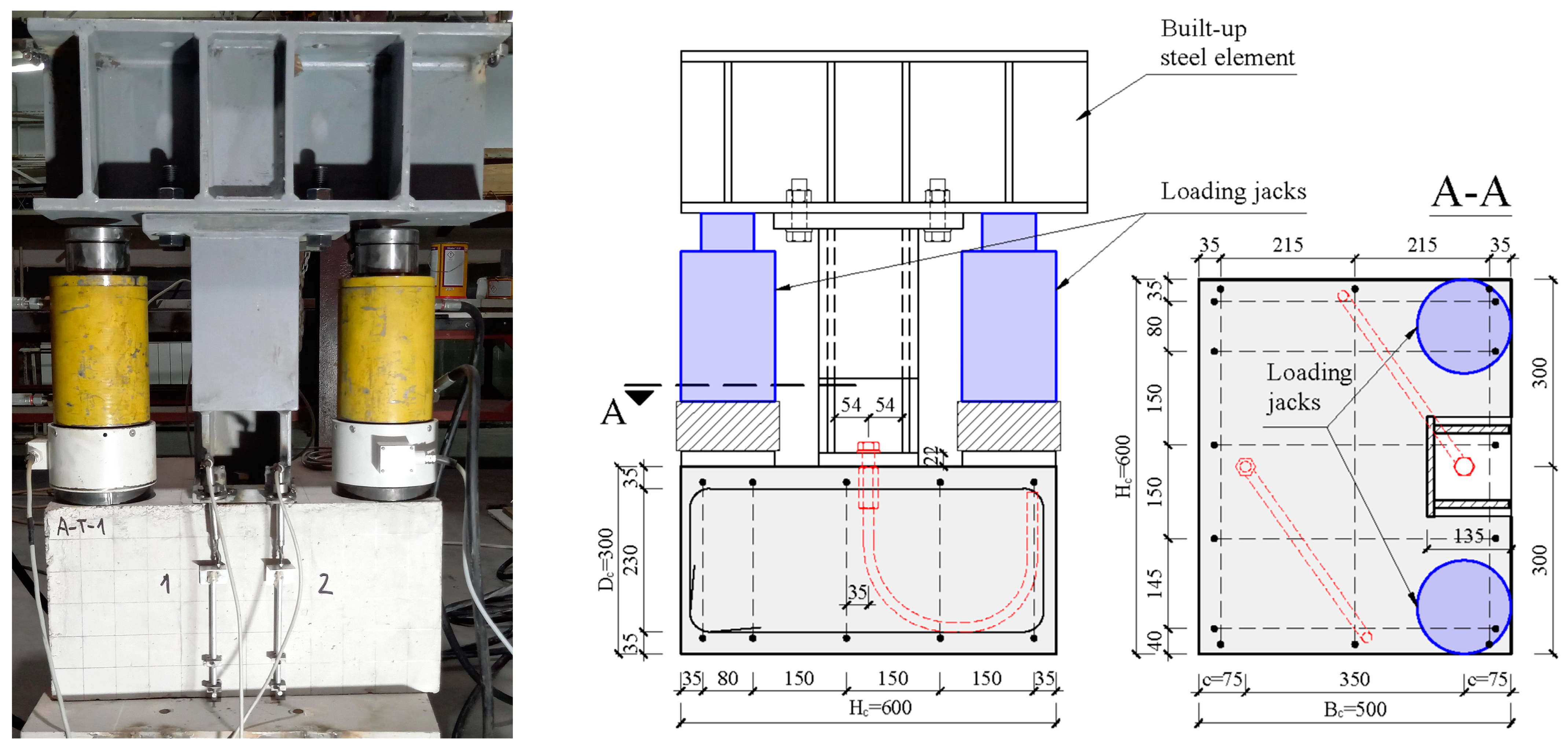
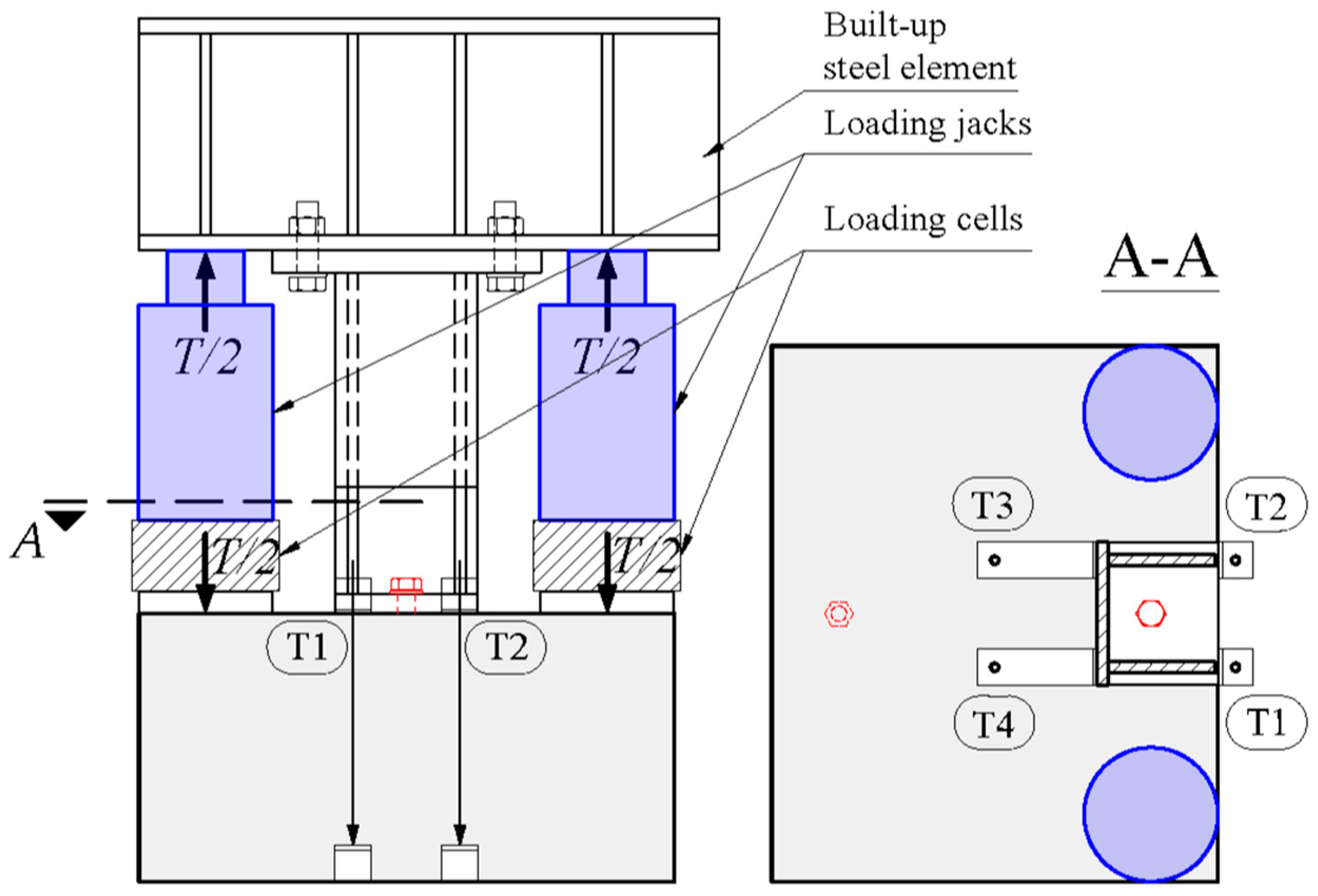


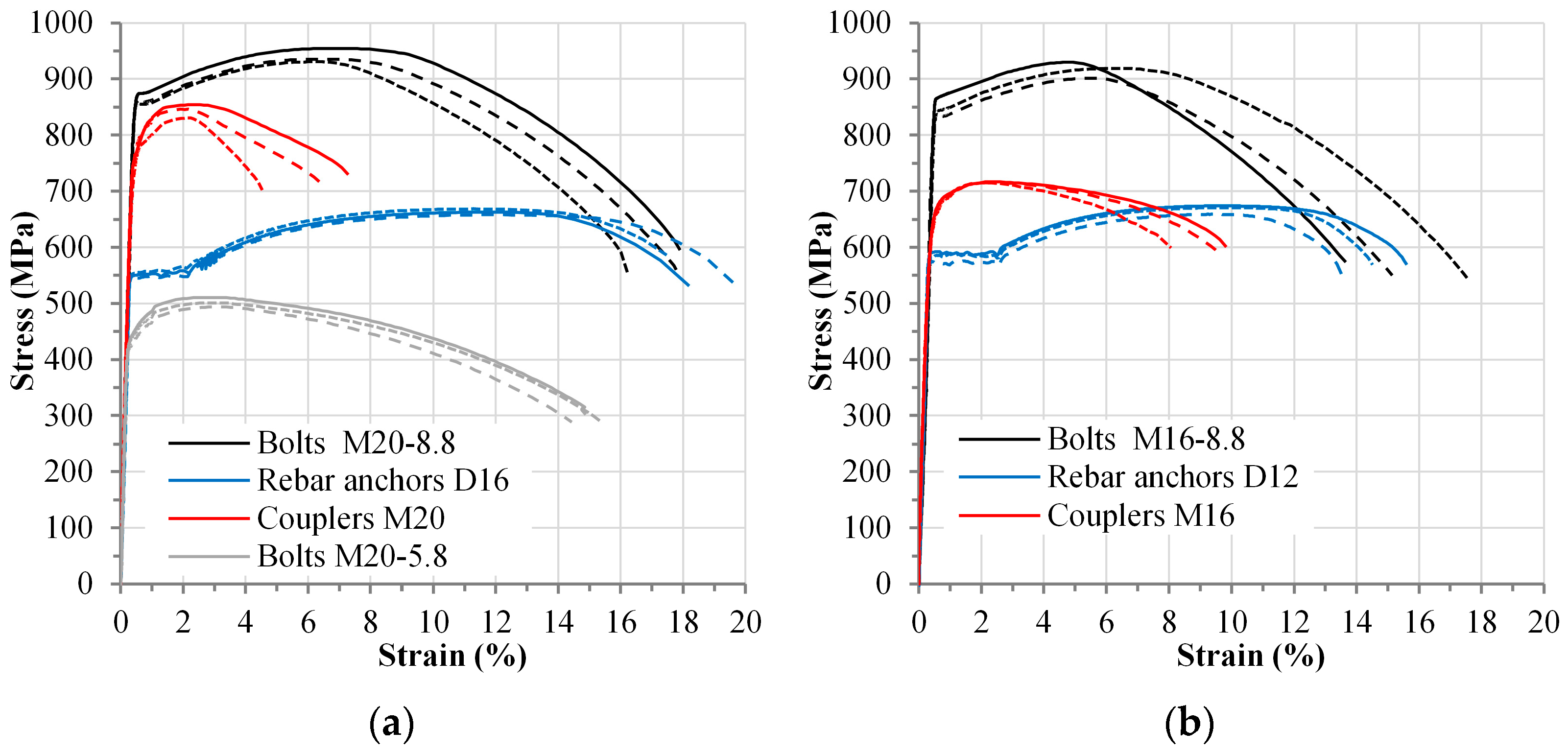
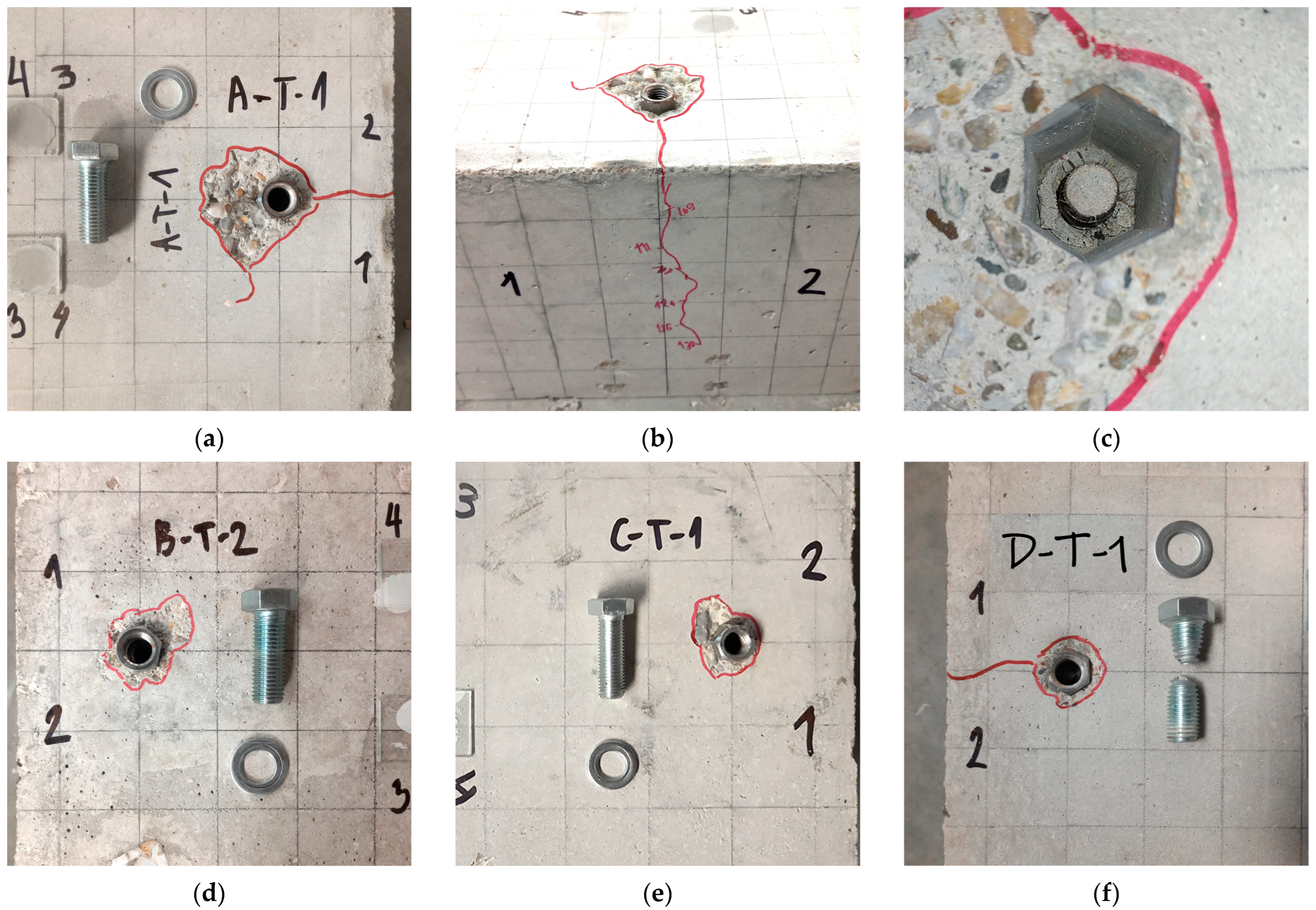

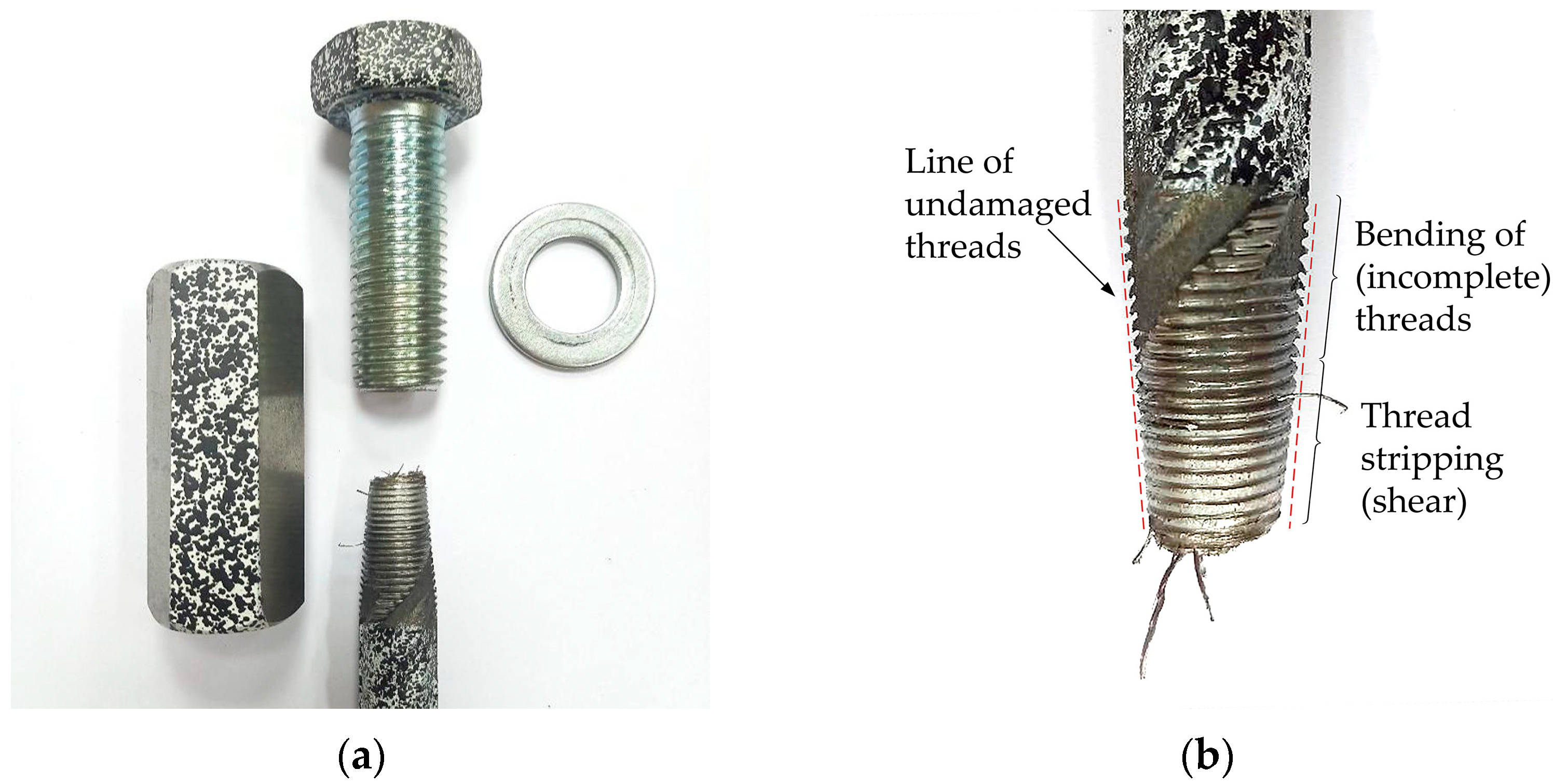

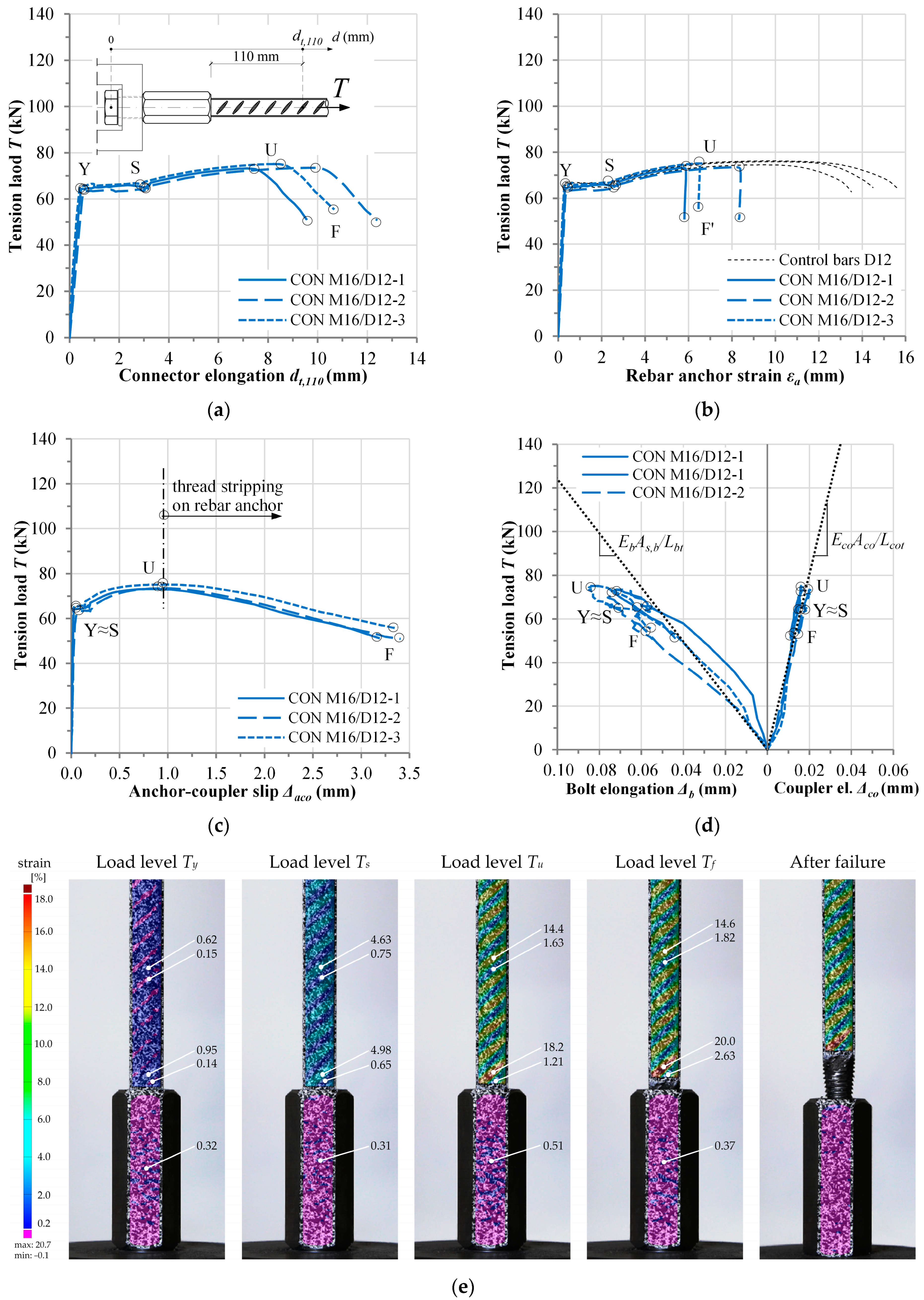
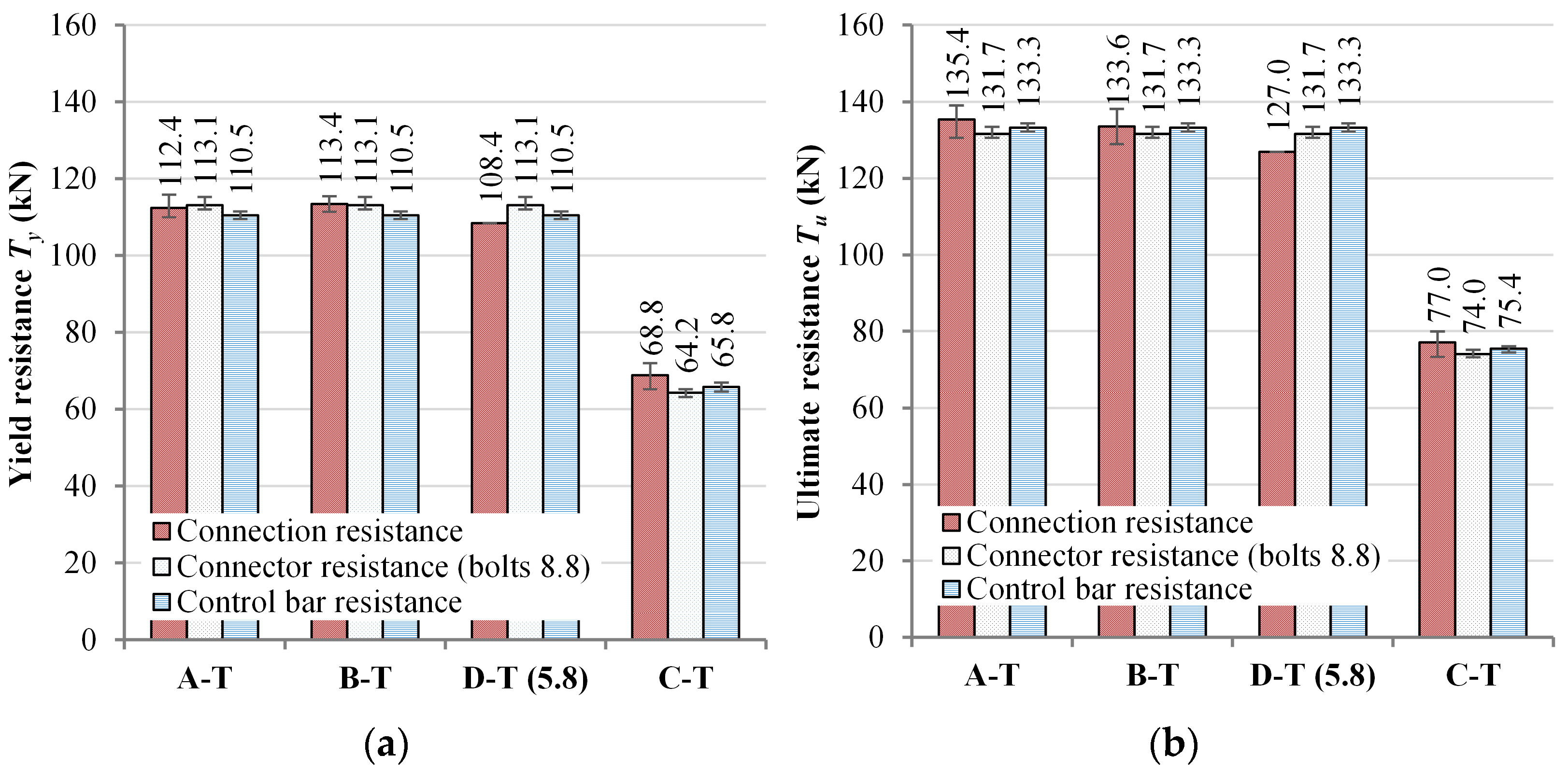
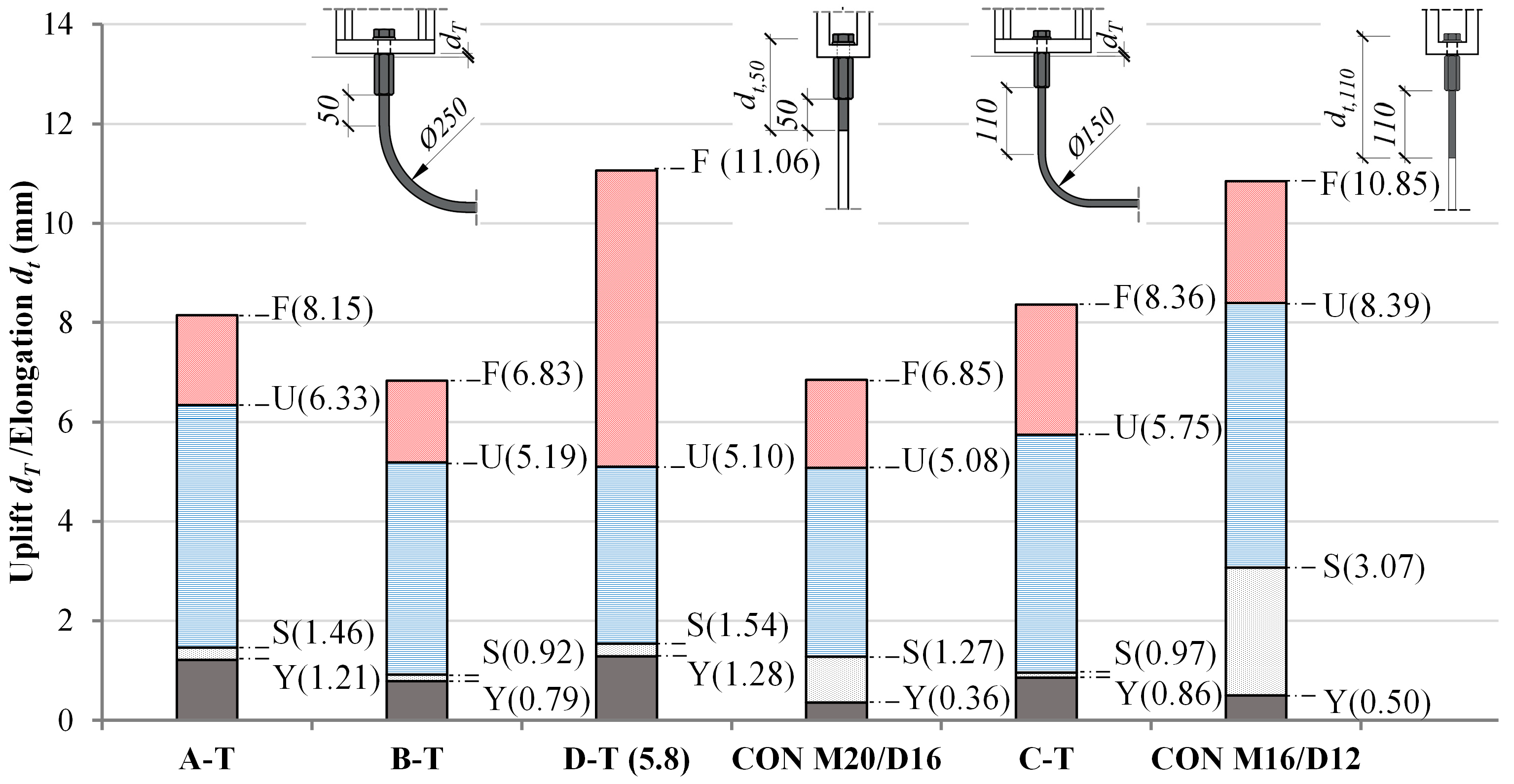
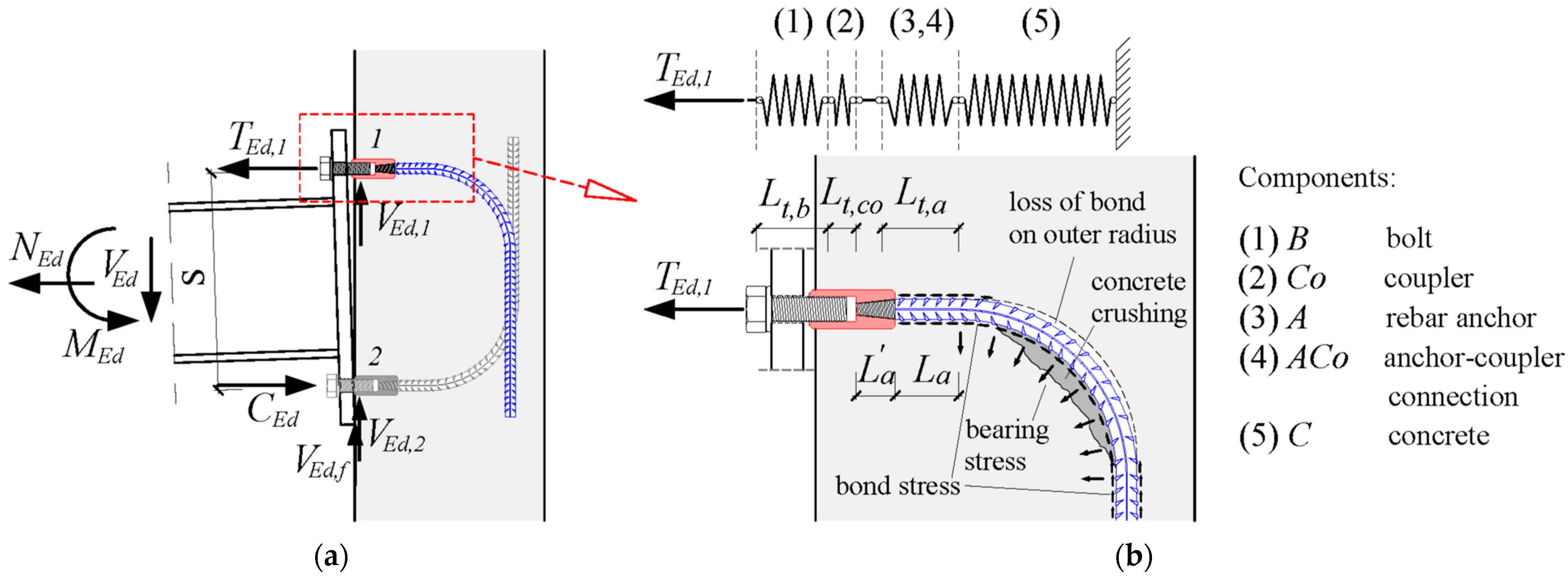
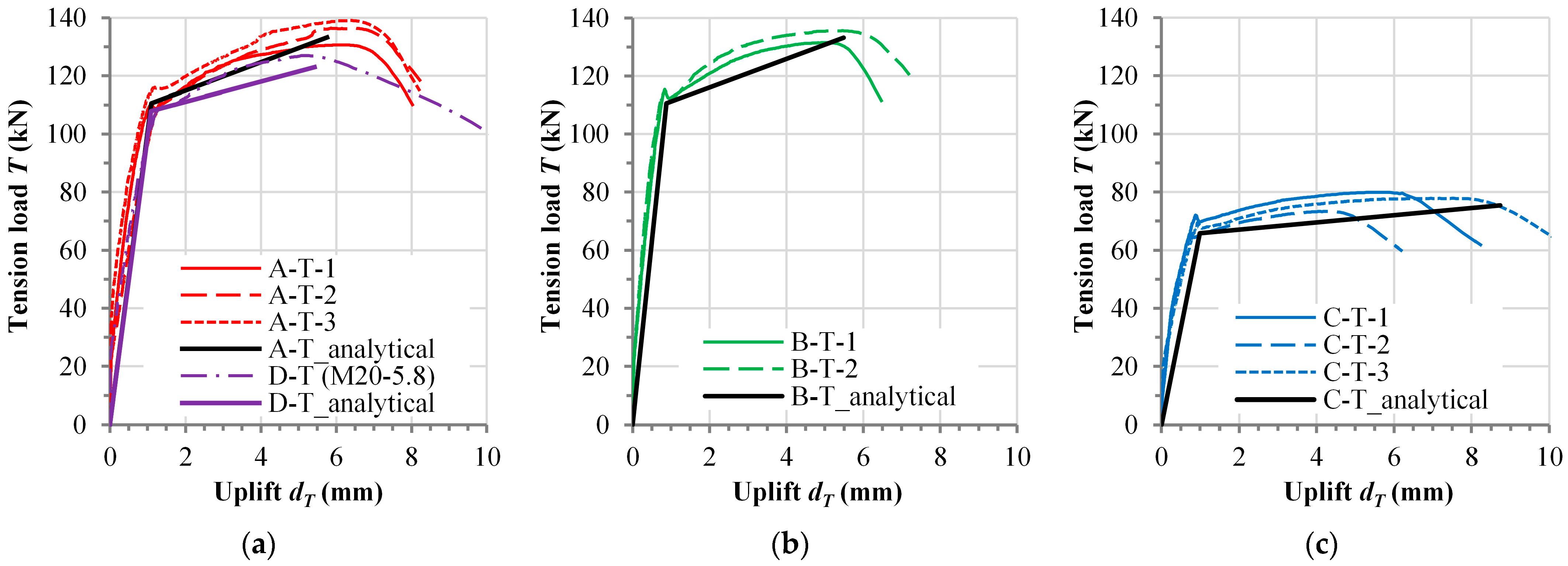
| Test Series | Bolt | Coupler | Rebar Anchor | Nominal Concrete Class | Edge Distance | Number of Specimens | ||||
|---|---|---|---|---|---|---|---|---|---|---|
| db (mm) | Grade (−) | dco (mm) | lco (mm) | da (mm) | la (mm) | Grade (−) | c (mm) | |||
| A-T | 20 | 8.8 | 27 | 68 | 16 | 640 a | B500B | C20/25 | 75 | 3 |
| B-T | 20 | 8.8 | 27 | 68 | 16 | 640 a | B500B | C30/37 | 75 | 2 |
| C-T | 16 | 8.8 | 22 | 58 | 12 | 490 b | B500B | C20/25 | 75 | 3 |
| D-T | 20 | 5.8 | 27 | 68 | 16 | 640 a | B500B | C20/25 | 75 | 1 |
| Test Series | Test Results | Mechanical Properties According to EN 1992-1-1 | |||||
|---|---|---|---|---|---|---|---|
| Testing Age t (Days) | fcm,cube(t) (MPa) | fctm,sp(t) (MPa) | Ecm(t) (MPa) | fcm(t) (MPa) | fctm(t) (MPa) | Ecm(t) (MPa) | |
| A-T | 55 | 31.1 | 2.58 | 28,974 | 24.9 | 2.09 | 28,927 |
| B-T | 90 | 49.2 | 3.76 | 32,753 | 39.4 | 3.05 | 33,187 |
| C-T | 55 | 31.1 | 2.58 | 28,974 | 24.9 | 2.09 | 28,927 |
| D-T | 55 | 31.1 | 2.58 | 28,974 | 24.9 | 2.09 | 28,927 |
| Specimen Series | Component of Connector | Diameter | Nominal Grade | Yield Strength | Ultimate Strength | Modulus of Elasticity | Fracture Strain | ||
|---|---|---|---|---|---|---|---|---|---|
| d (mm) | Mean fy (MPa) | CoV (%) | Mean fu (MPa) | CoV (%) | Mean E (GPa) | Mean εf (%) | |||
| A-T, B-T, D-T CON M20/D16 | Bolt | 20 | 8.8 | 862.7 | 1.16 | 940.3 | 1.35 | 203.7 | 17.32 |
| Bolt | 20 | 5.8 a | 440.6 | 2.18 | 501.7 | 1.69 | 207.9 | 14.85 | |
| Coupler | 27 | C45+C | 778.5 | 1.11 | 843.5 | 1.42 | 209.3 | 6.24 | |
| Reb. Anchor | 16 | B500B | 549.9 | 0.92 | 663.0 | 0.79 | 197.3 | 18.45 | |
| C-T, CON M16/D12 | Bolt | 16 | 8.8 | 847.7 | 2.26 | 916.6 | 1.56 | 197.4 | 15.44 |
| Coupler | 22 | C45+C | 653.4 | 0.86 | 715.7 | 0.15 | 203.1 | 8.91 | |
| Reb. Anchor | 12 | B500B | 582.4 | 1.80 | 667.8 | 1.19 | 202.9 | 14.53 | |
| Specimen Series | Specimen | Yielding Load | Ultimate Load | Failure Load | Failure Mode b | |||
|---|---|---|---|---|---|---|---|---|
| Ty (kN) | dT,y (mm) | Tu (kN) | dT,u (mm) | Tf (kN) | dT,f (mm) | |||
| A-T | A-T-1 | 110.0 | 1.11 | 130.6 | 6.18 | 110.1 | 8.03 | ACoF |
| A-T-2 | 111.4 | 1.36 | 136.5 | 6.45 | 118.4 | 8.22 | ||
| A-T-3 | 115.8 | 1.16 | 139.0 | 6.38 | 115.1 | 8.20 | ||
| Mean | 112.4 | 1.21 | 135.4 | 6.33 | 114.6 | 8.15 | ||
| St. deviation | 3.0 | 0.13 | 4.3 | 0.14 | ||||
| CoV (%) | 2.7 | 11.1 | 3.2 | 2.2 | ||||
| Characteristic | 102.2 | 0.76 | 120.9 | 5.86 | ||||
| B-T | B-T-1 | 115.4 | 0.84 | 131.5 | 5.09 | 111.5 | 6.47 | ACoF |
| B-T-2 | 111.3 | 0.74 | 135.7 | 5.28 | 120.7 | 7.18 | ||
| Mean | 113.4 | 0.79 | 133.6 | 5.19 | 116.1 | 6.83 | ||
| C-T | C-T-1 | 71.9 | 0.88 | 79.9 | 5.46 | 61.8 | 8.22 | ACoF |
| C-T-2 | 65.2 | 0.77 | 73.3 | 4.24 | 60.0 | 6.19 | ||
| C-T-3 | 69.4 | 0.94 | 77.8 | 7.54 | 59.9 | 10.66 | ||
| Mean | 68.8 | 0.86 | 77.0 | 5.75 | 60.6 | 8.36 | ||
| St. deviation | 3.4 | 0.09 | 3.4 | 1.67 | ||||
| CoV (%) | 4.9 | 9.9 | 4.4 | 29.1 | ||||
| Characteristic | 57.4 | 0.57 | 65.7 | - | ||||
| D-T | D-T-1 a | 108.4 | 1.28 | 127.0 | 5.10 | 91.2 | 11.06 | BF |
| Specimen Series | Specimen | Yielding Load | Ultimate Load | Failure Load | |||||||
|---|---|---|---|---|---|---|---|---|---|---|---|
| Ty (kN) | dt,y a (mm) | Δaco,y(mm) | Tu (kN) | dt,ua (mm) | Δaco,u(mm) | εu,a,con (%) | Tf (kN) | dt,f a (mm) | Δaco,f (mm) | ||
| CON M20/D16 | CON M20/D16-1 | 115.2 | 0.37 | 0.03 | 133.4 | 4.74 | 1.01 | 7.08 | 112.2 | 6.43 | 2.60 |
| CON M20/D16-2 | 112.0 | 0.26 | 0.03 | 130.6 | 5.45 | 0.91 | 8.61 | 107.5 | 7.16 | 2.54 | |
| CON M20/D16-3 | 112.1 | 0.46 | 0.05 | 131.0 | 5.07 | 1.10 | 7.31 | 110.2 | 6.95 | 3.01 | |
| Mean | 113.1 | 0.36 | 0.04 | 131.7 | 5.08 | 1.01 | 7.67 | 109.9 | 6.85 | 2.72 | |
| St. deviation | 1.8 | 0.10 | 1.5 | 0.36 | 0.83 | ||||||
| CoV (%) | 1.6 | 28.0 | 1.2 | 7.00 | 10.8 | ||||||
| Characteristic | 107.0 | - | 126.5 | 3.89 | 4.87 | ||||||
| CON M16/D12 | CON M16/D12-1 | 64.4 | 0.50 | 0.04 | 73.2 | 7.19 | 0.84 | 5.70 | 51.3 | 9.55 | 3.18 |
| CON M16/D12-1 | 63.1 | 0.58 | 0.07 | 73.5 | 9.75 | 0.96 | 8.09 | 51.0 | 12.37 | 3.40 | |
| CON M16/D12-1 | 65.1 | 0.43 | 0.03 | 75.1 | 8.24 | 0.96 | 6.44 | 55.8 | 10.64 | 3.34 | |
| Mean | 64.2 | 0.50 | 0.05 | 74.0 | 8.39 | 0.92 | 6.74 | 52.7 | 10.85 | 3.31 | |
| St. deviation | 1.0 | 0.08 | 1.0 | 1.3 | 1.23 | ||||||
| CoV (%) | 1.6 | 15.2 | 1.4 | 15.3 | 18.2 | ||||||
| Characteristic | 60.8 | 0.25 | 70.4 | 4.05 | 2.61 | ||||||
| Specimen Series | Concrete Strength | Bolt | Rebar Anchor | Mean Connection Stiffness | |||
|---|---|---|---|---|---|---|---|
| fcm(t) (MPa) | db (mm) | Grade | da (mm) | kT,in (kN/mm) | kT,s (kN/mm) | kT,y (kN/mm) | |
| A-T | 24.9 | 20 | 8.8 | 16 | 105.7 | 95.4 | 78.9 |
| B-T | 39.4 | 20 | 8.8 | 16 | 156.0 | 143.9 | 126.4 |
| C-T | 24.9 | 16 | 8.8 | 12 | 108.6 | 84.4 | 71.4 |
| D-T | 24.9 | 20 | 5.8 | 16 | 89.9 | 81.1 | 71.1 |
| Component | ID | Phase | Reference | Characteristic | Prediction Equations |
|---|---|---|---|---|---|
| Bolt | B (1) | Yield | adopted | Resistance [kN] | |
| EN 1993-1-8 [38] | Deformation capacity [mm] | ||||
| Ultimate | EN 1993-1-8 [38] | Resistance [kN] | |||
| adopted | Deformation capacity [mm] | ||||
| Coupler | Co (2) | Yield | adopted | Resistance [kN] | |
| adopted | Deformation capacity [mm] | ||||
| Ultimate | adopted | Resistance [kN] | |||
| adopted | Deformation capacity [mm] | ||||
| Rebar anchor and anchor-coupler conn. | A (3), ACo (4) | Yield | EN 1992-1-1 [26] | Resistance [kN] | |
| EN 1992-1-1 [26] | Deformation capacity [mm] | ||||
| Ultimate | EN 1992-1-1 [26] | Resistance [kN] | |||
| EN 1992-1-1 [26] | Deformation capacity [mm] | or | |||
| Concrete | C (5) | Yield | modified from EN 1992-1-1 [26] | Resistance [MPa] | |
| proposed | Deformation based on connector resistance [mm] | ||||
| Ultimate | modified from EN 1992-1-1 [26] | Resistance [MPa] | |||
| proposed | Deformation based on connector resistance [mm] |
Disclaimer/Publisher’s Note: The statements, opinions and data contained in all publications are solely those of the individual author(s) and contributor(s) and not of MDPI and/or the editor(s). MDPI and/or the editor(s) disclaim responsibility for any injury to people or property resulting from any ideas, methods, instructions or products referred to in the content. |
© 2025 by the authors. Licensee MDPI, Basel, Switzerland. This article is an open access article distributed under the terms and conditions of the Creative Commons Attribution (CC BY) license (https://creativecommons.org/licenses/by/4.0/).
Share and Cite
Milićević, I.; Milosavljević, B.; Spremić, M. Behavior of Demountable Connections with Taper Threaded Mechanical Coupler (TTC) and Rebar Anchor Under Tension Load. Buildings 2025, 15, 928. https://doi.org/10.3390/buildings15060928
Milićević I, Milosavljević B, Spremić M. Behavior of Demountable Connections with Taper Threaded Mechanical Coupler (TTC) and Rebar Anchor Under Tension Load. Buildings. 2025; 15(6):928. https://doi.org/10.3390/buildings15060928
Chicago/Turabian StyleMilićević, Ivan, Branko Milosavljević, and Milan Spremić. 2025. "Behavior of Demountable Connections with Taper Threaded Mechanical Coupler (TTC) and Rebar Anchor Under Tension Load" Buildings 15, no. 6: 928. https://doi.org/10.3390/buildings15060928
APA StyleMilićević, I., Milosavljević, B., & Spremić, M. (2025). Behavior of Demountable Connections with Taper Threaded Mechanical Coupler (TTC) and Rebar Anchor Under Tension Load. Buildings, 15(6), 928. https://doi.org/10.3390/buildings15060928






